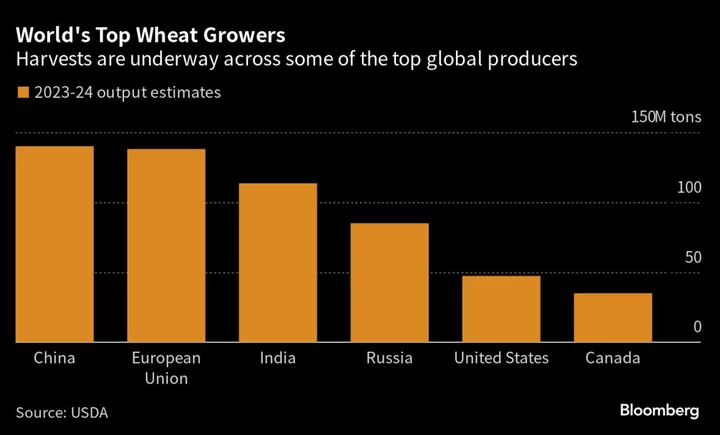Wheat harvests rolling in across the Northern Hemisphere are bolstering global supply. But bad weather and the war in Ukraine are leaving top-quality crops harder to come by.
Tractors in northern Europe have been stalled by persistent rain, while Ukrainian wheat quality has also been dented as Russia’s invasion drains farmers’ funds. As for China, much of the harvest is only suitable for feeding to chickens and pigs.
That’s curbing the portion of wheat suitable for food staples like bread and noodles, even as global production could still notch an all-time high. It will also heighten focus on exporters further south, where harvests lie several months ahead.
“There will be less milling wheat available,” said Dan Basse, president of Chicago consultant AgResource. “We need to have some really sizable and good-protein, good-quality crops in both Argentina and Australia to kind of bridge the gap.”
Here’s the situation across some of the biggest Northern Hemisphere producers:
Black Sea
Top shipper Russia is expecting another large harvest after a record crop last season, but rains — especially in southern regions — mean quality will likely trail the average.
About 74% of wheat harvested as of July 31 was food quality, versus 91% at a similar time last year, according to Russia’s grain quality assessment center. Those figures reflect an early portion of the crop and Russia’s overflowing grain ports and low local prices are still boosting the appeal of its supply.
The situation is far worse in Ukraine: Just 35% to 40% of wheat will likely be milling quality, the lowest of the past decade, according to UkrAgroConsult. Not only have farmers had to contend with wet weather, Moscow’s invasion has curbed the use of inputs like fertilizer. Crucially, the end of the Black Sea grain deal is also limiting the country’s outlets to global market.
Europe
Northern stretches of the European Union — the world’s No. 2 exporter — have faced heavier-than-usual rain in the past month. France was able to collect the bulk of its soft-wheat beforehand, but the storms are denting quality of the final leg. Less than a fifth of the German wheat harvest was completed by early August.
Mature wheat left too long in fields can lean or lodge — making it harder to harvest once conditions clear, said Megan Hesketh, senior analyst at the Agriculture and Horticulture Development Board in the UK, where rains have also held up fieldwork.
The “heavily delayed” harvest is also spurring concerns about lower-than-normal protein — which gives dough its stretch — and sprouting grains, German crop handler Agravis said in a statement.
“The rain is persistent and daily,” Katharina Geiger, crop production policy adviser at farmer association DBV, said by email. “Farmers in the north of Germany in particular fear that fungal growth could increase sharply due to the moisture and make the grain unusable.”
China
Torrential rains hit major Chinese wheat regions at harvest, curbing output versus last year and damaging quality in the world’s biggest producer and consumer. Persistent rains in the north left a large volume of the harvest sprouted and moldy, making it only suitable for livestock consumption.
The country jumped to the top of the global import ranks in the season that just ended and the damage could necessitate another year of strong purchases — although unlikely to exceed the last, according to Beijing-based agriculture consultancy BOABC. China is likely to produce 63.7 million tons of milling-grade wheat in the 2023-24 season, down 40% from the previous year, it forecasts.
“Overall we don’t have supply issues at home,” said Ma Wenfeng, an analyst at BOABC. “But the millers, namely the state-owned firms, would step up purchases of good-quality wheat from the international market, when there are profits.”
North America
Drier weather could bode well for grain quality in North America’s wheat belt, although it’s limiting output. Back-to-back droughts kept US production of hard red winter-wheat — used for all-purpose flour — near the lowest since the 1960s. Parts of Canada have also been gripped by dry spells.
Coupled with heightened trade worries in the Black Sea, that has helped lift Chicago wheat futures 16% from their low earlier this year. The US Department of Agriculture is expected to cut its global stockpiles forecast in a report on Friday.
“We’re back to a risk-on mentality with wheat,” said Pete Levangie, chief executive officer of flour maker Bay State Milling in Massachusetts.
Author: Megan Durisin, Áine Quinn, Hallie Gu and Michael Hirtzer

